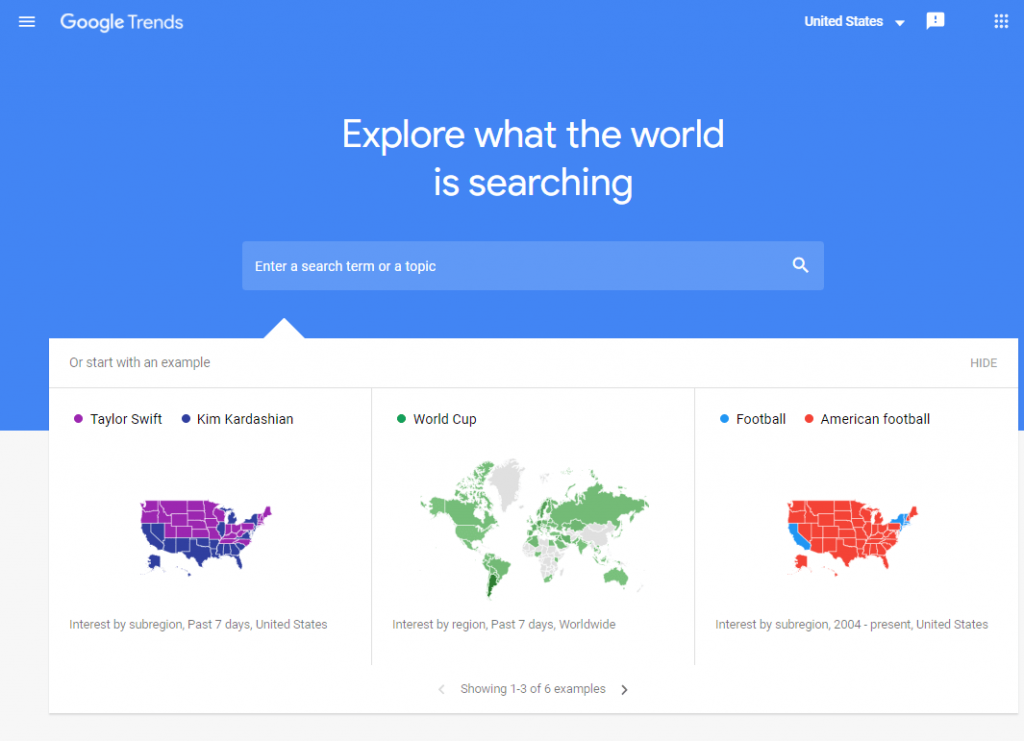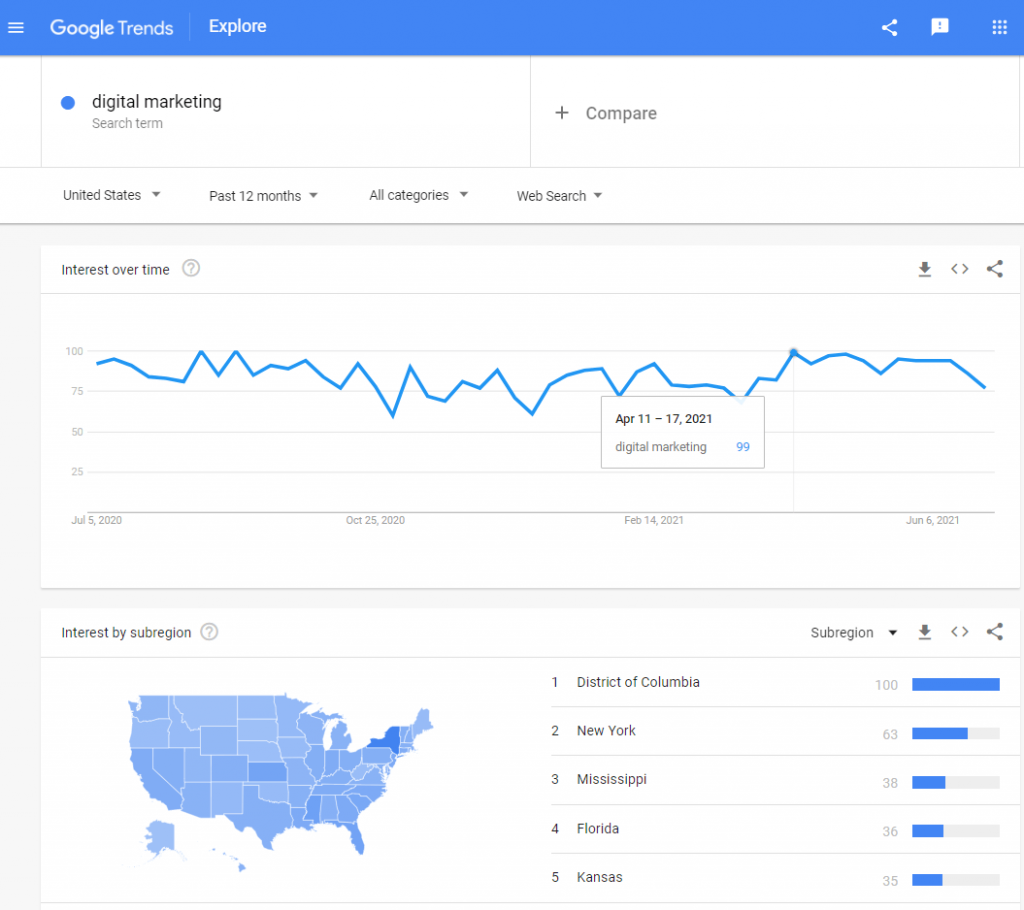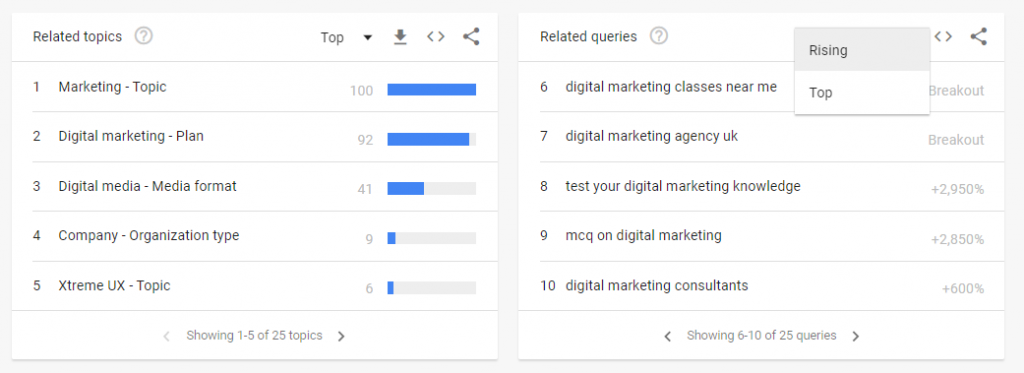Of all the apps, tools, and platforms Google offers, Google Trends is one that can often be overlooked by both online advertisers and regular people alike. It’s not ubiquitous like YouTube, Maps or Gmail, and not built-in to your work role as a marketer like Google Ads. But it can be really helpful, is immediately accessible to even the most tech-illiterate, and has multiple uses.
So why don’t more businesses use it?
First off — what is Google Trends?
Google Trends is a completely free tool offered by Google that analyzes the popularity of top search terms and topics across different regions and languages. You can see terms that are currently trending, as well as how often those terms were searched for over time.
From there, you can further segment data based on topic, location, time frame, category, and type of search — that is, standard web search, news, shopping, or YouTube.
You can also use Google Trends to search for multiple terms and compare their search frequency.
Screenshot of Google Trends Home Page
How to use it
Right on the homepage at trends.google.com you’ll find the Trends search bar, where you can start with a term or use their examples that are included directly below.
For example, a search for “digital marketing” would show you that people have searched for that on a pretty steady basis, although it was a bit more frequent in mid-April 2021 and early September 2020. You’d also see that the most common area from which it’s searched is Washington, DC, followed by New York and then, perhaps surprisingly, Mississippi. Below that, you’d see related topics and frequently searched related queries.
The scale this is measured on is Google’s “interest” score. This is on the Y axis and goes from zero to 100, representing search interest relative to terms with the highest interest. A value of 100 for a search term is peak popularity, a value of 50 means the term is half as popular, and a score of 0 means there wasn’t enough data — in other words, it usually wasn’t searched much at all.
Screenshot of Google Trends Explore Page
Between that and the term search bar are the dropdown menus where you can segment by country, categories, or on which platform the term was searched. You can also change the time range; thus you can look at search frequencies for your term over as short a span as the last 12 hours, or as long as since 2004. The default time span you’re shown is the last year.
In the related queries display beneath the term frequency graph, you can toggle between “top” queries and “rising” queries. The former is just the most common related search terms, whereas the latter indicates terms that have the most significant growth in your chosen time span. A query marked with “breakout” means that term’s frequency has grown by more than 5,000%.
Screenshot of Google Trends Related Topics & Queries
How you as a marketer can improve your SEO with Google Trends
Unlike many tools that are useful but only for one or two specific purposes, Google Trends can be utilized by marketers in a bunch of different ways — the only true limit is your own creativity with how to use it.
The most basic, straightforward use is to conduct keyword research. Here you can view the popularity of different search terms and get ideas about keywords related to search terms you’re planning on using in your content or for search ad campaigns, plus see if a term is trending upward or if it’s becoming obsolete. Furthermore, you can also learn more about the seasonality of keywords; certain relevant ones may show up more during certain holidays, times of year, or large events, and you can tailor your related content to correspond to that. This information can similarly inform your Google Ads campaigns.
A related use is analyzing keywords by region, particularly if your business is brick-and-mortar or is otherwise bound by locale. For example, if you’re a creamery in Washington and you see the search term huckleberry ice cream is frequently searched, that could signal it’s something you want to pursue in your content or ad campaigns. But then you dig into the regional tendencies and see that the primary driver of this traffic are users in Montana, you’d want to rethink that. (Obviously this is theoretical, as huckleberry ice cream rules and there’s no way that could go unnoticed in Washington.)
One of Google Trends’ sneakily helpful uses, via its ability to compare multiple terms simultaneously, is to analyze your own visibility versus competitors. How frequently are your brand name and product names being searched compared to your competitors’ names, products, and related terms? In which direction are these frequencies trending?
Screenshot of Google Trends Compare View
Lastly, Google Trends can be great for when you’re stuck in a rut and need help brainstorming new ideas for your content production. Going down a rabbit hole on Trends with different terms, related queries, and topics can help jumpstart new ideas, or reinvigorate and improve old ones.
Lots of digital marketing, metrics, and associated tools can be a bit daunting. Luckily, Google Trends is completely the opposite — it’s super easy to use, requires no specialized knowledge, and can be applied in a whole bunch of different ways. By incorporating Google Trends into your digital repertoire, you’re giving your business’ online presence an almost automatic boost for minimal effort! We think it feels crazy to not use it, so we hope you take advantage of it, too.








